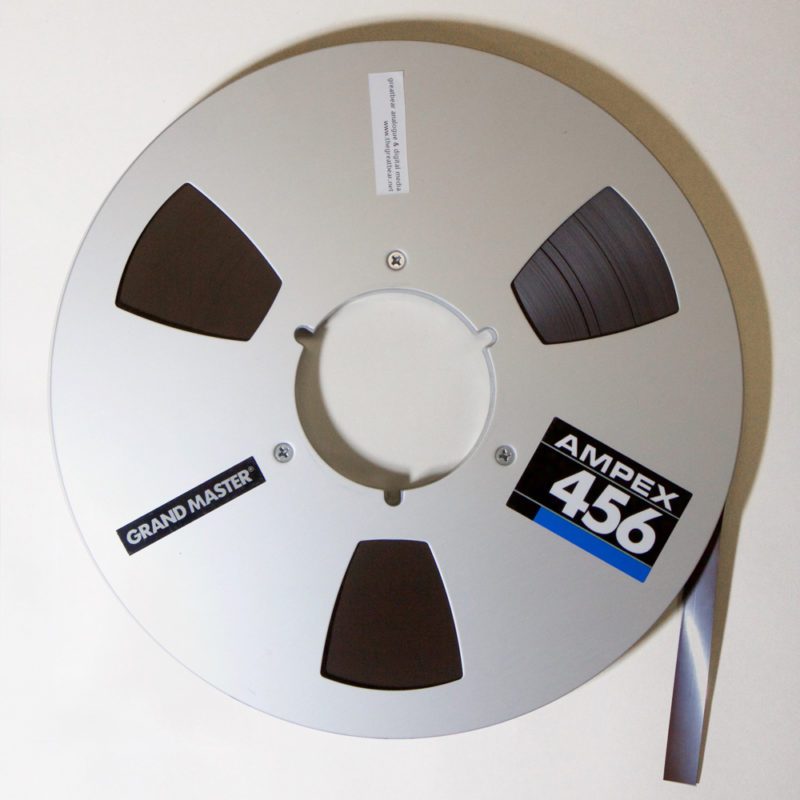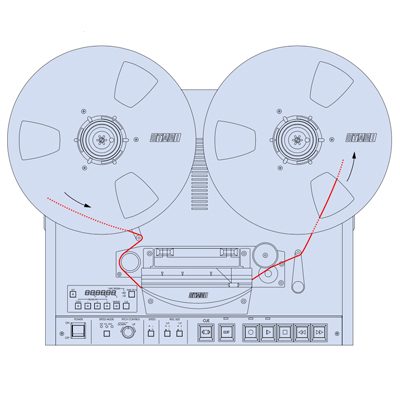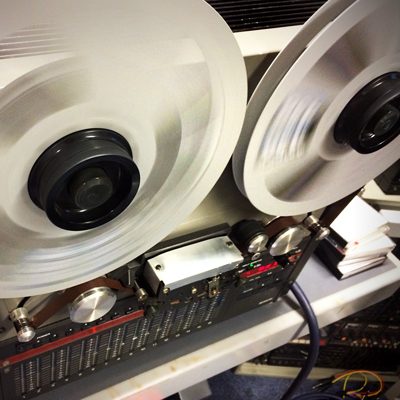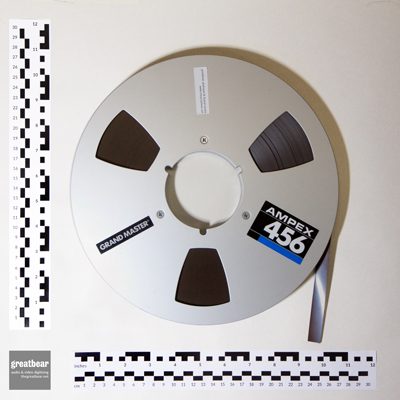introduction to ½ inch multitrack audio tape transfer
For small sound recording studios, 8-track ½" multitrack was a more useful and flexible form of recording than 4-track ¼" multitrack, and better quality than 8-track ¼" multitrack. As a result 8-track and 16-track ½" multitrack recordings are some of the most common open reel tape formats we are asked to digitise and preserve.
As explained in more detail below, these forms of analogue multitrack recording have small but significant details that affect their preservation, which we are careful to address - including tape degradation and correct noise reduction decoding. This requires a range of processes and (similar but significantly different) machines that we have collected, restored and can use to digitise your recordings at the highest possible quality.
We offer a range of delivery formats for our audio transfers. Following International Association of Sound and Audiovisual Archives TC-04 guidelines, we deliver 24-bit / 96 kHz high resolution Broadcast WAV files, together with MP3 audio file or audio CD listening versions. We're happy to create any other digital audio files, according to your needs. We can also digitise to 24-bit / 192 kHz, if required.
We can provide the appropriately-sized USB delivery media for your files, or use media supplied by you, or deliver your files online. Files delivered on hard drive can be for any operating system - MacOS, Windows or GNU/Linux and filesystems (HFS+, NTFS or EXT3).
½" reel-to-reel tapes can vary in duration and in the extent of physical tape degradation, so we always assess tapes before confirming the price of a transfer.
We offer free assessments - please contact us to discuss your project.
For an introduction to our assessment and treatment processes, please see our guide to "what happens to your audio tape".
½ inch multitrack reel-to-reel machines
The ½" tape width format was used by a range of manufacturers in the small, project and home studio markets, starting with the Teac 80-8 in the late 1970s.
Teac, Tascam, Otari and Fostex all developed machines that used this tape width, offering 8 or 16 tracks with either dbx or Dolby C noise reduction internally or via external units. Teac, Tascam and Otari developed 8-track machines while Fostex in 1983 released the B16 that managed to squeeze 16 tracks on ½" tape at 15 inches per second, using Dolby C internally as a switchable noise reduction option. Tascam caught up and in 1988 released the MSR16 that also squeezed 16 tracks onto ½" tape, but offered dbx type I internal noise reduction and an additional 7.5 inches per second speed option.
We keep and maintain the following ½" tape machines that can handle almost all the ½" variations:
- Teac 80-8, ½ inch, 8-track multitrack
- Otari MX5050 ½ inch, 8-track multitrack
- Fostex B16 ½ inch, 16-track multitrack
- Tascam TSR8, ½ inch, 8-track multitrack
½ inch multitrack format variation
| track format | tape speed | reel size | reel hub type | noise reduction | supported |
|---|---|---|---|---|---|
| 8-track | 15 | 10 ½ | NAB | no noise reduction | ✓ |
| 15 | 10 ½ | NAB | dbx Type I | ✓ | |
| 15 | 10 ½ | NAB | Bel BC3 | ✓ | |
| 15 | 10 ½ | NAB | Dolby C | ✗ | |
| 16-track | 15 | 10 ½ | NAB | no noise reduction | ✓ |
| 15 | 10 ½ | NAB | Dolby C | ✓ | |
| 15 | 10 ½ | NAB | Bel BC3 | ✓ | |
| 15 | 10 ½ | NAB | Dolby S | ✗ | |
| 15 | 10 ½ | NAB | dbx Type I | ✗ |
Scroll to the right to view full table on smaller screens.
½ inch multitrack tape risks & vulnerabilities
We often receive reels in a poor condition with a variety of physical problems with a variety of causes:
- poor storage such as mould growth, uneven wind tension or poor tape pack / pack slip caused by long term horizontal storage.
- age and tape chemistry such as as loss of lubricant, ‘sticky shed syndrome‘ or broken, dried out splices
- poor handling or damage such as twisted, broken, crinkled or stretched tape and sometimes bags of tape unwound!
These types of problems and more must be addressed before a tape can be satisfactorily transferred.
½" multitrack tape, being a format often used non-professionally, frequently arrives without any notes about standard of noise reduction used, or any calibration tones - making accurate setup of our machines to match the recording more tricky. If the noise reduction standard isn't known it can sometimes be ascertained from careful listening for artefacts, knowledge of the original machine or studio used, or by comparing multiple passes of the tape using different setups.
We recently received some very early ½" 8-track tapes that had been stored poorly in an environment of wide temperature range. They were also Ampex-branded and had been played back before coming to us, while suffering from sticky shed syndrome. As a result these tapes exhibited severe delamination, where the binder and back coating were falling off the plastic body of the tape. While this is rare it can happen with some tape and in severe cases like this the recording can be lost.
Machine obsolescence is a growing problem with many tape formats, though it hasn't rendered this format dead as yet. However, key parts to these machines, such as their record / repro heads, haven't been available new for many years, and we rely on our store of parts and spare machines to keep these running. It will only become more difficult to do this in the future, so it's a good idea to preserve your ½" recordings now.





